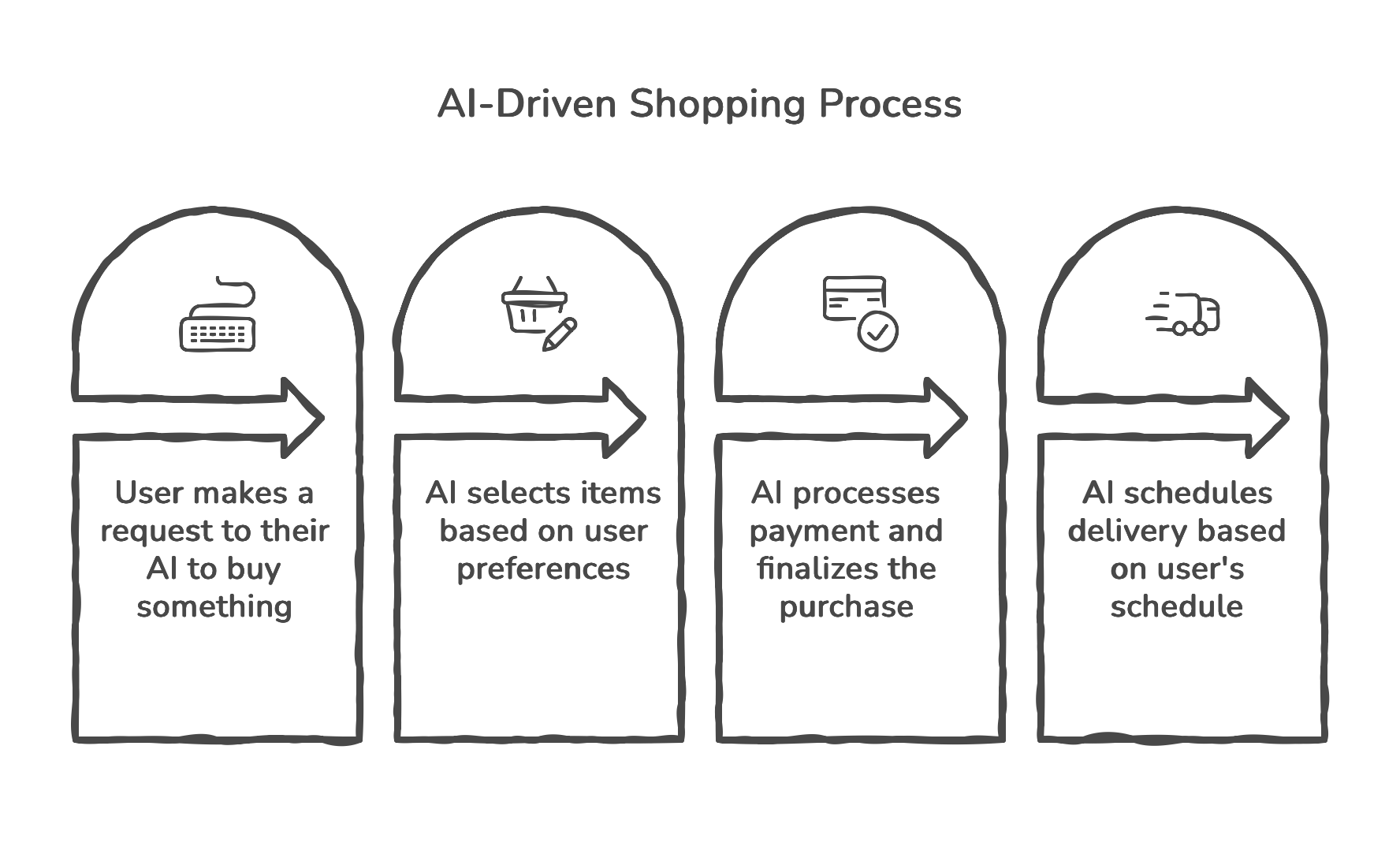Most people still think of AI as a “helpful assistant.” A useful tool that gives you answers, suggestions, writes summaries, or recommends what to buy... That’s already old news.
We’re now entering a world where AI doesn’t just recommend -it takes action, and it buys on your behalf.
Welcome to Agentic Commerce, where AI agents build shopping baskets, complete checkouts, and even handle delivery details, all without a single human click.

Not going to be at home? AI knows, as it'll be connected to your calendar. So you can even schedule specific days for delivery.
This is all closer than you think, and now is the time to prepare.
AI’s next move: From advisor to personal shopper
Until now, eCommerce has revolved around humans making micro-decisions, such as what to search for, what to click, and which buttons to press.
But as OpenAI, Google, and Amazon roll out agent frameworks like ACP (Agent Commerce Protocol) and AP2, those steps are getting automated.
Instead of opening the Etsy website to search for and buy a handmade mug, your AI agent does it:
“Order the handmade ceramic mug I liked last time, from the same seller, before it sells out.” Done. No browser. No cart. No clicks.

ChatGPT has already tested instant checkout via Etsy. Stripe is partnering on payment delegation. Google’s now pushing secure “agent-to-platform” transactions. And Amazon’s Rufus quietly sits inside their ecosystem, learning exactly how and what people buy.
No doubt Claude and Perplexity are working on something similar.
The infrastructure is forming right under our noses, and it's progressing at an exciting pace.
Your website isn't your only storefront anymore
Here’s the opportunity - in the world of agentic commerce, your storefront is expanding beyond just your website. Your product data, API, and checkout integration are now a new shop window.
If an AI agent can easily parse your product feed, confirm stock, verify price, and complete a transaction, you’ll be one of the early adopters gaining visibility in this new channel.

Pretty sliders and pixel-perfect UX still matter for humans - but for AI agents, clean data, clear logic, and low friction are the new design language.
This is a massive mindset shift. The “SEO” of the next five years isn’t just ranking pages, it’s optimising your machine-readable commerce layer.
SEO is too big to go anywhere, and it'll still dominate for years to come, but this is a massive new opportunity.
Who’s building this future?
Right now, the big players are shaping the pipes:
- OpenAI + Stripe (ACP): powering delegated payments directly inside AI tools.
- Google (AP2): creating open protocols for authenticated, secure agent-to-merchant commerce.
- Amazon (Rufus): leveraging its own data to keep buying inside its walls.
- Card networks (Visa, Mastercard, etc): moving toward agent identity and token-based authorisations.
Don’t worry if these acronyms sound abstract; most of this will be handled by your existing platforms and providers. The opportunity lies in how ready your data is, rather than in how technical you are.
It’s a bit 'Wild West' still. Some will push open standards; others will lock merchants into closed ecosystems. But the momentum is undeniable - every major tech company wants its AI to be the buyer, not just the broker.
What this means for eCommerce brands
If you run an online store, this shift hits three core layers:
- Discovery: Agents won’t “browse.” They’ll query structured product data. Optimising your schema, feed, and metadata can now be considered SEO for AI conversations. And yes, I'm still referring to it as SEO. It absolutely isn't GEO.
- Checkout: Instant, API-driven transactions will need to integrate into your checkout. If your checkout process is flexible and API-friendly, you’ll be ready for the next wave of seamless transactions..
- Fulfilment: Delivery times, reliability, and return policies will directly influence agent choices. No more hiding bad reviews or complex T&Cs - AI doesn’t forget.

Essentially, your “visibility” will be determined by data quality, trust signals, and operational transparency - not by who’s best at running Facebook ads.
What’s already happening
We’re seeing early signals:
- ChatGPT + Etsy: AI-assisted checkout is in early testing.
- Shopify: quietly expanding APIs for agent-driven commerce.
- WooCommerce: as above.
- Payment networks: experimenting with delegated payment tokens.
- Retail AI pilots: some brands already feeding structured product data to LLM partners.
The first use cases will be relatively straightforward, involving reorders, subscriptions, and low-risk purchases. But once people trust it, expect agents to handle complex decisions (e.g. “Find me the best eco-friendly sofa under £1,000 that delivers before Friday”).
The brands investing in accessible, trustworthy data will quietly start winning first.
How to prepare
Here’s where the innovative brands will get ahead:
Clean your product feed
- Manage your data properly. Make every field complete and accurate: price, stock, reviews, delivery, dimensions, colour - everything. If you don't have a field, create one.
- Agents can’t “guess” or fill in blanks.
Expose structured data
- Don’t trap product info behind CMS templates or PDFs.
Talk to your payment provider
- Ask about ACP/AP2 compatibility, delegated payments, and tokenisation.
Simplify shipping & returns
- Friction-free logistics = higher “visibility” with agents.
Monitor visibility
- Track what product data is actually being surfaced in AI layers.
Reframe marketing
- Think “AI comprehension” instead of “human persuasion.”
- Focus on reliability, transparency, and data consistency.
Start small
- Begin with one well-structured feed or an API-ready product line.
Risks, challenges and realities
Let’s not sugarcoat it. This comes with issues:
- Fraud and liability: Who’s responsible if an agent orders the wrong item?
- User control: How much autonomy will consumers really give up?
- Platform lock-in: Will small stores be forced into walled gardens?
- Regulation: Expect debates around consent, privacy, and payment authorisation.

We’ll see phased adoption, not an overnight revolution. Expect simple, low-risk purchases first, then proceed to bigger, more complex transactions as trust and standards evolve.
The window for early advantage is now
If this feels like 2000s SEO or 2008 Google Ads - that’s because it is.
We’re watching the early stages of a new optimisation layer for commerce. The brands that act now - by managing and enriching product data, cleaning feeds, opening APIs, and testing agent compatibility - will build a compound advantage long before the mainstream catches on.

In a couple of years, some brands will still be wondering why their competitors have an advantage, while early adopters will already be thriving inside the AI ecosystem. Be the business whose competitors look on with envy!
Agentic commerce isn’t a ‘what if.’ It’s already under construction. And just like with SEO, those who adapt first tend to stay ahead longest.






